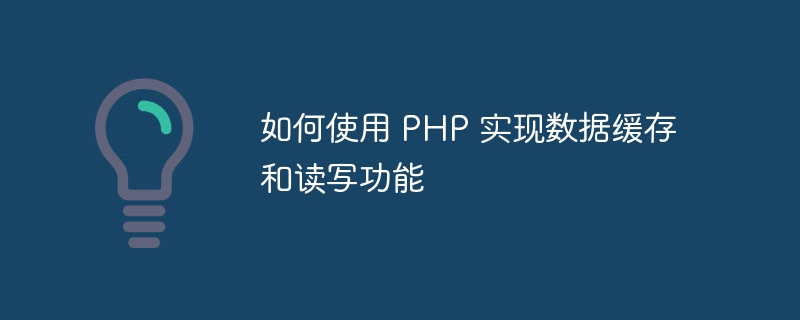Home >Backend Development >PHP Tutorial >How to use PHP to implement data caching, reading and writing functions
How to use PHP to implement data caching, reading and writing functions
- 王林Original
- 2023-09-05 17:45:161117browse

How to use PHP to implement data caching and reading and writing functions
Caching is an important way to improve system performance. Frequently used data can be stored in memory through caching in to increase data reading speed. In PHP, we can use various methods to implement data caching and reading and writing functions. This article will introduce two common methods: using file caching and using memory caching.
1. Use file cache
File cache stores data in files for subsequent reading. The following is a sample code that uses file caching to read and write data:
// 写入缓存文件
function writeCache($key, $value, $expire = 3600) {
$filename = "/path/to/cache/{$key}.txt";
$data = serialize([
'expire' => time() + $expire,
'value' => $value
]);
file_put_contents($filename, $data);
}
// 读取缓存文件
function readCache($key) {
$filename = "/path/to/cache/{$key}.txt";
if (file_exists($filename)) {
$data = file_get_contents($filename);
$cache = unserialize($data);
if ($cache['expire'] >= time()) {
return $cache['value'];
} else {
// 缓存过期,删除缓存文件
unlink($filename);
}
}
return null; // 缓存不存在或已过期,返回null
}Using the above code, data can be stored in the cache file under the specified path. Among them, the writeCache function is used to write cached data, and the readCache function is used to read cached data. When writing to the cache, you can set the cache expiration time, which defaults to 3600 seconds (i.e. 1 hour). When reading the cache, if the cache file exists and has not expired, the cache data is returned; otherwise, null is returned. When data is updated, cache files need to be deleted manually.
2. Use memory cache
Memory cache stores data in memory to increase the reading speed of data. In PHP, commonly used memory caching tools include Redis and Memcached. The following is a sample code that uses Redis to implement memory caching:
// 连接 Redis 服务器
$redis = new Redis();
$redis->connect('127.0.0.1', 6379);
// 写入缓存数据
function writeCache($key, $value, $expire = 3600) {
global $redis;
$redis->set($key, $value);
$redis->expire($key, $expire);
}
// 读取缓存数据
function readCache($key) {
global $redis;
return $redis->get($key);
}To use the above code, you need to first install the Redis extension and start the Redis server. When writing to the cache, use the set method to store the data in Redis, and use the expire method to set the cache expiration time. When reading the cache, use the get method to obtain the cache data.
It should be noted that when using memory cache, you need to ensure that the Redis or Memcached server is running normally and the connection parameters are correctly configured.
Summary: Data caching is a common method to improve system performance. In PHP, file caching and memory caching can be used to implement data caching, reading and writing functions. Using file caching is simple and suitable for small-scale data caching; while using memory caching can improve reading speed and is suitable for large-scale data caching. Choosing an appropriate cache method based on actual needs can significantly improve system performance.
The above is an introduction and code examples on how to use PHP to implement data caching and reading and writing functions. I hope it will be helpful to you.
The above is the detailed content of How to use PHP to implement data caching, reading and writing functions. For more information, please follow other related articles on the PHP Chinese website!

